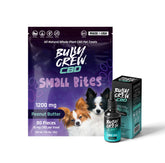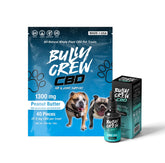It’s a sound that can break the quiet of any room: the relentless, rhythmic licking of a dog focused on one spot. At first, you might dismiss it. But when days turn into weeks, and you discover a raw, inflamed, and stubborn wound on your dog’s leg, concern turns to alarm. You’re likely dealing with a canine granuloma, one of the most frustrating and complex skin conditions a dog can develop.
This condition is more than just a skin lesion; it's a prominent, physical signal that something deeper is amiss, physically or psychologically. To truly help your companion heal, you must look beyond the wound itself and play detective. This in-depth guide will walk you through the science of granulomas, the different types you might encounter, and how a multifaceted approach, including supportive therapies like CBD, is the key to finally breaking the cycle.
What Exactly is a Granuloma? The Body's Protective Fortress
Before we can treat it, we need to understand what a granuloma actually is. At its most basic level, a granuloma is not a disease, but rather the body’s highly specialized inflammatory reaction to a persistent threat. Think of it as a microscopic fortress. When the immune system encounters an irritant, be it stubborn bacteria, a fungal invader, a splinter, or even chronic Inflammation, it switches from attack to containment. The process of being granulomatous in dogs is a powerful defense mechanism.
The body dispatches waves of immune cells, primarily macrophages, to the site. These cells surround the threat, effectively walling it off from the rest of the body to prevent it from spreading. This collection of organized immune cells forms a firm, raised nodule, or lump, that we call a granuloma. While this quarantine strategy is brilliant, the resulting lesion itself becomes a source of pain, itching, and potential secondary infection, creating a new problem to solve.
Related: 6 Ways to Cure lick granulomas in dogs
The most infamous type, the canine lick granuloma, is locked in a self-perpetuating cycle:
-
Initial Trigger: Something causes the dog to start licking.
-
Inflammation: Constant licking damages the skin, causing it to become inflamed, itchy, and painful.
-
Compulsive Licking: The discomfort drives the dog to lick even more to soothe the area.
-
Worsening Lesion: This intensified licking causes deeper tissue damage, invites infection, and thickens the skin, making the problem even more severe.
Decoding the Types of Granulomas:
While they can appear similar, granulomas have vastly different root causes. A proper diagnosis from your veterinarian is critical, as the treatment for one type will not work for another.
1. Canine Lick Granuloma (The Most Common Culprit) This is the classic, self-inflicted wound that most owners associate with the term. Acral refers to a limb, which is why these almost always appear on the front of a dog's lower leg, wrist (carpus), or ankle (tarsus). To find the right canine lick granuloma treatment, we must first answer the common question: what causes lick granuloma in dogs?

-
Psychological Triggers: For many dogs, licking is a coping mechanism. Boredom, extended periods of confinement, separation anxiety, or the stress of a new family member can all trigger this obsessive behavior. Licking releases endorphins, the body's natural painkillers and mood elevators, making the dog feel better temporarily. This powerful chemical reward makes the behavior addictive and incredibly difficult to stop. In some cases, it can be a true canine Obsessive-Compulsive Disorder (OCD).
-
Physical Triggers: The licking may start from a legitimate physical issue. Common culprits include environmental or food allergies causing a localized itch, a painful joint from osteoarthritis, nerve pain (neuropathy), a minor puncture wound, a bee sting, or even a bacterial or yeast infection. The dog licks to soothe the pain or itch, and the cycle begins.
2. Foreign Body Granuloma (The Hidden Intruder) A foreign body granuloma forms when the body discovers a physical object it cannot absorb or break down. The immune system’s only option is to encapsulate it.

-
Causes: These are often caused by plant material like splinters, thorns, or sneaky grass seeds (foxtails) that have worked their way under the skin. It can also be a reaction to non-organic material, such as suture material from a past surgery that the body is rejecting.
-
Appearance: This typically presents as a firm, non-painful lump that appears weeks or months after the foreign object entered the body. They can sometimes form a draining tract if the body is attempting to expel the object.
3. Eosinophilic Granuloma (The Allergic Reaction) An eosinophilic granuloma is a specific type of inflammatory lesion characterized by a large number of white blood cells called eosinophils.

-
Causes: This is almost always part of a larger allergic or hypersensitivity reaction. It's the body's over-the-top response to a perceived major threat, such as flea bites (flea allergy dermatitis), food allergens, or environmental triggers like pollen.
-
Appearance: These lesions often appear as raised, red plaques or nodules, sometimes ulcerated. They can be found on the skin, between the toes, or even inside the mouth. While any dog can be affected, it is seen more frequently in certain breeds, such as Siberian Huskies and Cavalier King Charles Spaniels.
4. Infectious Granuloma (The Stubborn Siege) Sometimes, an infectious granuloma is the body's last-ditch effort to contain a persistent, deep-seated infection that standard immune responses couldn't clear.

-
Causes: These are typically caused by microorganisms that are notoriously difficult to kill, such as certain types of deep fungal infections (e.g., blastomycosis, cryptococcosis) or specific bacteria (e.g., mycobacteria).
-
Treatment: This type requires aggressive, long-term treatment with specific antifungal or antibiotic medications, as simply managing the lump will not clear the underlying infection.
The Crucial Role of Your Veterinarian in Diagnosis
Because the treatments are so different, self-diagnosing is not an option. Your veterinarian is your most important partner in solving this puzzle. To get to the root cause of a canine granuloma, they will likely perform a combination of diagnostics:
-
Complete Physical Exam: To check for signs of pain, arthritis, or allergies elsewhere on the body.
-
Skin Cytology and Scrapings: To look for bacteria, yeast, or mites.
-
X-rays: To rule out underlying bone issues, injuries, or arthritis.
-
Biopsy and Culture: A small tissue sample can be taken to identify the types of cells involved (confirming a granuloma) and to culture for specific fungal or bacterial culprits.
-
Allergy Testing: To identify potential environmental or food triggers.
The Supportive Role of CBD in Managing Canine Granulomas
Once a proper diagnosis is made, treatment will focus on the root cause. However, managing the symptoms of pain, Inflammation, and anxiety is a critical part of the healing process. This is where CBD (cannabidiol) has emerged as a powerful holistic tool, especially for the complex nature of a canine lick granuloma.
Important Disclaimer:
Always consult with your veterinarian before adding any supplement, including CBD, to your dog's regimen. They can ensure it won’t interfere with other medications and help you find a safe, effective dose.
CBD works by supporting the body’s endocannabinoid system, a master regulatory network that helps maintain balance (homeostasis). Here’s how it can specifically help with granulomas:
1. Targeting Inflammation at the Source A granuloma is, by its very nature, a mass of Inflammation. CBD is renowned for its potent natural anti-inflammatory properties.
-
How it helps: By reducing the inflammatory response in the skin, CBD can help decrease the redness, swelling, and, most importantly, the intense itchiness that drives the licking cycle. A less itchy dog is far less likely to lick, giving the wound a chance to finally heal.
2. Alleviating Underlying Pain If the granuloma was triggered by a painful condition like arthritis, simply covering the wound won't solve the problem.
-
How it helps: CBD is also a powerful analgesic (pain reliever). It can help soothe the chronic, deep-seated pain in a joint or limb that may have started the licking in the first place. By managing the source of the pain, you remove your dog’s motivation to self-soothe through licking.
3. Soothing Anxiety and Compulsive Behaviors This is perhaps the most crucial role for CBD in any canine lick granuloma treatment plan. If the root cause is behavioral, no amount of skin cream will work long-term.
-
How it helps: CBD has well-documented anxiolytic (anti-anxiety) effects. It can help calm a dog suffering from separation anxiety, stress, or general nervousness. By promoting a sense of well-being and calm, it reduces the compulsive urge to lick. This addresses the psychological engine driving the behavior, which is essential for preventing a relapse or the formation of a new granuloma elsewhere.
What CBD Cannot Do: It is vital to have realistic expectations. CBD will not remove a foxtail from a foreign body granuloma or cure a systemic infectious granuloma. Those conditions require direct veterinary intervention. However, CBD can still be used as a complementary therapy in those cases to manage the secondary Inflammation and discomfort, making your dog more comfortable during treatment.
Conclusion:
A canine granuloma is a complex and challenging condition that demands more than a simple solution. It requires patience, diligent investigation, and a true partnership between you and your veterinarian. The journey to healing involves a multi-pronged attack: breaking the physical cycle of licking, healing the damaged skin, and, most critically, identifying and resolving the root cause.
By integrating supportive, holistic therapies like CBD to manage the Inflammation, pain, and anxiety that fuel the fire, you can provide your dog with comprehensive care. With a dedicated and well-rounded approach, you can finally quiet the constant licking, heal the persistent wound, and restore both your dog’s well-being and your own peace of mind.







